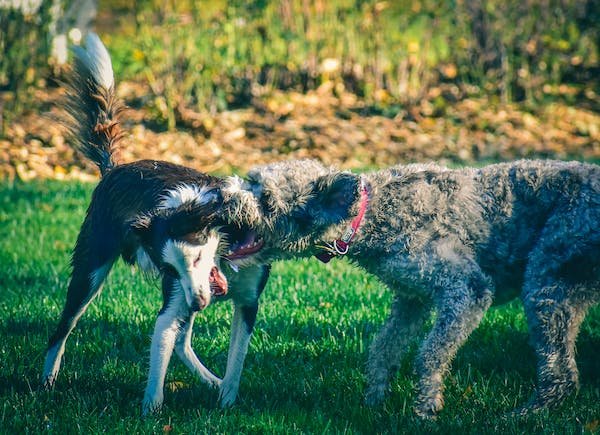Learn About the Genes, Maintenance, and Instruction of White and Black Bernedoodles to Uncover Their Charm
Among creative dog breeds, Bernesedoodles are unique due to their established appearance and charming personality. These gorgeous crossbreeds blend the intelligence and grace of the Poodle with the kind, loving nature of the Bernese Mountain Dog. They are the results of the two breeds’ marriage. Even though Bernedoodles come in a wide variety of colors, including merle, golden, and tri-color, the classic black and white coat mix is still highly looked after by dog lovers worldwide.
Because of how well their dark and creamy colors mix, black and white Bernedoodles are very appealing. Their unique patterns, which commonly have suit or panda bear similarities, add to their enchanting attractiveness. These cute dogs always manage to leave a mark, whether they’re running around in the yard, getting on the sofa, or dazzling visitors with their behavior.
In this comprehensive guide, we embarked on a mission to solve the codes behind the unique coat color of the black and white Bernedoodle. To provide current and possible Bernedoodle owners with the knowledge and tools necessary to care for these wonderful friends, we will cover a wide range of topics, from the detailed genetics that control their color distribution to practical grooming tips tailored to their particular needs.
We’ll also discuss the crucial socialization and training methods specific to black and white Bernedoodles, helping owners raise nice and gentle dogs. We’ll also talk about the various health problems that might arise from this coat color variation, allowing owners to prioritize the physical and mental well-being of their Bernedoodles.
Bernedoodle Coat Color Genes: Learning the Inheritance Patterns
A complex interaction of genes transmitted from both of their parent breeds, the Poodle and the Bernese Mountain Dog, determines the fur colors of Bernedoodles. These genes pass down in pairs, one from both parents, and they might be weak or strong. White marks are caused by genes that limit or decrease pigment production in certain regions, whereas black coloring is usually caused by genes that create a substance called a kind of pigment responsible for dark hues.

This theory states that inheritance occurs when genes that dominate increase the effects of weak genes. A Bernedoodle, for example, may sport a mostly black coat with few white markings if it receives a singular dominant black trait and one negative white gene. On the other hand, if both parents have inherited white genes, the baby may have a coat that is mostly white or have more significant white markings.
Gaining knowledge about the genetics of coat color in Bernedoodles will help you better understand the inheritance trends that determine their particular look. Breeders and owners may better enjoy and learn about the wide range of colors and designs seen in this popular designer species by studying the genetic codes underlying the coat hues.
Knowledge of Inheritance Patterns
Bernedoodles, like numerous other dog breeds, get their coat color from the genes they receive from other dog species. Each parent gives their kid a collection of genes that control numerous traits, such as coat color, when a Bernese Mountain Dog and a Poodle breed together. These genes are weak or in charge, and they are inherited in pairs, one from each parent.
The exact gene mix that the Bernese Mountain Dog and the Poodle share affects whether a black or white Bernedoodle will have black or white coloration. The genes that create a substance called a kind of black that causes dark hues are usually responsible for the black coloration, but genes that limit or decrease pigment production in certain regions of the coat contribute to the white patterns.
According to a form of Men dominant DNA will amplify the effects of recessive elements which is how coat color is inherited. For instance, a Bernedoodle with a primary black gene from a single parent and one weak white gene from the other may have a coat that is mostly black with very little white markings. On the other hand, the child may have a coat that is mostly white or more significant white markings if both parents have recessive white genes.
Factors Affecting Differences Between Black and White Coats
Bernedoodle coat color is largely determined by genes, but outside factors can also affect how some genes are expressed, leading to differences in coat color. Subtle differences in coat hues and patterns between children might result from variables like changes in temperature in pregnancy and during fetal growth, which can affect the function of genes involved in color conclusion.
Furthermore, Bernedoodle coat color may be subject to molecular variables, which include stress, food, and sensitivity to certain chemicals. These variables can change how genes are active or blocked, which can result in differences in coat hue and design, even though they might not directly change the genetic code.
All things considered, the interaction of genetic transfer and environmental factors results in the vast range of coat colors and patterns that are seen in Bernedoodles, including the wonderful black and white varieties that have won the hearts of dog lovers all over the globe.
Tips for Taking Care of Your White and Black Bernedoodles
Regular brushing and the right maintenance methods are needed to keep the rich hair of black and white Bernedoodles in good condition. To avoid matting, remove loose fur, and evenly spread natural oils across the coat, start by combing your Bernedoodle’s coat a few times a week at the very least. Choose a premium brush or comb that is suitable for the texture of your Bernedoodle’s coat; if possible, use brushes or combs with soft hairs or teeth to prevent pain or burns.
Use a gentle shampoo designed for dogs to clean their coats without losing their natural oils when washing your Bernedoodle. To avoid skin irritation, remove any shampoo remains. To assist remove the coat and repair moisture, think about applying a conditioner. When your Bernedoodle has finished bathing, gently pat dry its coat with a towel and use a low-heat blow dryer to finish drying it fully to avoid skin problems.
To keep the coat looking nice and to avoid covering, it must be cut regularly, particularly to tangle-prone places such as under the legs and the ears. To keep these areas neat and clear of extra hair that may block vision or create pain, pay special attention to cutting around the nose, ears, and paws.
Make regular visits with a knowledgeable stylist who has worked with Bernedoodles before you begin grooming your dog if you’re not sure how to groom them or prefer to get expert help. To ensure your Bernedoodle looks and feels its best, a professional groomer may offer specialized grooming treatments catered to their particular coat type.
Your black and white Bernedoodle’s cover will stay colorful, healthy, and attractive for years to come.
Taking Care of Their Special Coat Texture
The long, smooth coat of the breed of Bernese Mountain Dog and the curly, sensitive hair of the Poodle combine to create the excellent coat texture that makes black and white Bernedoodles famous. Because of this special blend, the coat is silky and airy and needs proper treatment to stay that way.
To properly handle the special coat texture of Bernedoodles that are black and white, it is necessary to follow a regular grooming program. Start by cleaning your Bernedoodle’s coat with a premium brush or comb made for their particular coat type at least a few times each week. For releasing organic oils across the coat, getting rid of depart fur, and avoiding matting, a grooming rake or smoother brush are excellent tools.
Pay special attention to tangle-prone regions including the neck, between the legs, and the ears. Use a wide-toothed comb to lightly release any tangled materials. Take time when grooming your Bernedoodle, paying attention not to damage or scrape its sensitive skin.
Washing is an important aspect of keeping your Bernedoodle’s hair healthy in addition to routine brushing. For dogs with different kinds of hair that require extra care, use a gentle shampoo as well as a conditioner that will cleanse and moisturize their fur before exposing it to essential oils. Make sure every bit of shampoo and conditioner is fully wiped off to prevent skin reactions and pain.
Once your Bernedoodle has taken a bath, gently dry them with a gentle towel and use a low-temperature blow hairdryer to give their coat a last groom. Maintain a safe distance from the dryer to minimize pain and heating up, and make sure their coat washes fully to avoid microbial infections or skin problems like hot spots.
Resources and Methods for Efficient Grooming
You need to use the right equipment and techniques while brushing black and white Bernedoodles to achieve the finest outcomes. Spend on high-quality grooming tools including filters, brushes, and cuts that are specifically designed to fit the nature of your Bernedoodle’s clothing.
For efficient tangle and covering removal, use a grooming rake or faster brush when brushing. These are very helpful tools for getting through Bernedoodles’ thick, curly fur and avoiding matting.
To get a consistent finish while cutting your Bernedoodle’s coat, use powerful scissors or clips and go slowly and carefully. To keep your pet looking nice and clean, pay special attention to regions that are subject to matting or growth, such as the area around the pupils, ears, and paw pads. Trim any extra fur in these places.
Frequent brushing sessions provide good skin and coat health in addition to keeping your Bernedoodle appearing their best. You can successfully manage the different coat textures of your black and white Bernedoodle. And make sure they stay happy, healthy, and well-groomed. using the proper products and techniques and creating a regular grooming practice.
Healthcare Concerns for White and Black Bernedoodles
Loved for their gorgeous appearances and loving attitude, black and white Bernedoodles are beloved family members in many homes. Like any dog breed, they might experience certain health problems, nevertheless, that call for quick treatment and care. The tendency to specific illnesses may be attributed to certain genetic variables. Linked to coat variations, even if coat color alone does not directly affect health. It’s crucial to recognize these possible health issues and take steps to avoid them to guarantee your pet’s general well-being.
Typical Health Problems with This Color Scheme
While black and white Bernedoodles typically make durable and adaptable pets. They do have particular medical problems to be wary of. Which may be prevalent in a certain color of fur variations. One of the most frequent diseases is hip malformation. A genetic condition affecting the bones of the hip and resulting in discomfort. Limitation, and decreased mobility. In addition, genetic eye conditions including tumors. Or progressive AMD (PRA), which can someday affect vision. May affect Bernedoodles, particularly those with black or white coats.
In addition, dogs of any coat color may have digestive issues, ear infections, and skin reactions in Bernedoodles. Even though there is no apparent connection between these illnesses and coat color. Your Bernedoodle will need careful management. And veterinarians care to stay healthy and happy.
Avoidance Strategies for Optimal Health
You must give preventive treatment and routine doctor exams the greatest importance. To protect your black and white Bernedoodle from illness and injury. Providing your Bernedoodle with a nutritious, rich source of diet that matches. Their unique requirements are the first step to guaranteeing. They get everything they need for optimal wellness and energy. Daily physical activity is essential for keeping a normal weight, improving heart function, and preventing obesity-related issues.
Regular medical expert checks are important for managing your Bernedoodle’s overall wellness and identifying any potential issues earlier on. Consult your veterinarian about your Bernedoodle’s genetic traits. And coat color variance to make sure the right screening. And preventive treatments are in place. This could involve conducting genetic testing. For particular diseases or putting safeguards in place. Like taking joint supplements to promote hip health.
For black and white Bernedoodles, proper grooming, and cleanliness are just as important as receiving veterinarian treatment. Groom your Bernedoodle regularly to maintain. Its hair is healthy and shining by distributing natural oils. Preventing matting, and removing depart fur. They should wash their teeth often to lower them. The chance of dental problems and cleaning. Their ears regularly to prevent illnesses.
You can guarantee your Bernedoodle has a long, cheerful, and healthy life. As a valued member of your family by taking early action. With their medical care and by putting safeguards in place. You may have many years of happy times with your black and white Bernedoodle. If you give it the right care and attention take it to the vet regularly.
Techniques for Positive Reinforcement Training
The main goal of positive reinforcement methods of training is to boost desired actions with playtime, treats, or praise. Since Bernedoodles love companionship and respond well to encouragement, these techniques are particularly well-suited for them. Here’s how to use training techniques based on positive reinforcement.
Treat-Based Education of White and Black Bernedoodles:
Reward actions you want, such as sitting, remaining, or showing up when called, with small, delicious treats. Select expensive treats that your Bernedoodle adores, and give them to him right away when he exhibits the required behavior.
Clicker Learning:
Clicker training marks desired actions using a clicker, a tiny, mobile gadget that produces a distinctive clicking sound. To establish a distinct link between clicking and the reward, pair the device that clicks with goodies. Accurate timing is possible with clicker training, which is also useful for molding intricate behaviors.
Vocal Gratitude:
To encourage desired actions, use vocal praise like “good puppy” or “well done” in addition to rewards. Verbal praise may be used in addition to rewards to promote excellent behavior. And your Bernedoodle will love the positive focus and encouragement.
Playtime Prize:
Give your Bernedoodle some downtime in exchange for excellent behavior. During lessons, use fun games like balls, pull toys, or discs as rewards for acceptance. Playtime helps to build stronger bonds between you and your Bernedoodle while also rewarding desired behaviors.
Timing and Reliability of White and Black Bernedoodles:
Use praising and prizes regularly, and give them to your Bernedoodle as soon as they exhibit the behavior you want. Your dog will learn and retain information more quickly. If you are consistent and provide the right time for them. To associate the behavior with the reward.
Handling Bernedoodle-Specific Behavioral Issues
Although Bernedoodles are often intelligent, flexible dogs, they might have behavioral issues that need to be addressed and trained. The following list of typical Bernedoodle behavioral issues and strategies for resolving them with positive reinforcement.
Inflexibility:
Like their parent breeds, Bernedoodles may possess stubborn traits. To overcome resolve, train your dog with patience and consistency, and use rewards to encourage obedience.
Anxiety related to division:
Due to their intense attachment to their owners, Bernedoodles are known to suffer from anxiety and fear when left alone. Use relaxation methods to slowly train your Bernedoodle to be alone to resolve anxiety when separated. Additionally, make sure they have enough of both mental and physical exercise to keep them busy while you are away.
Overbarking:
Bernedoodles, like many other dogs, may bark loudly in reaction to a variety of situations. To stop your Bernedoodle from barking a great deal, teach him alternately. Behaviors like “quiet” or “speak” on demand using positive reinforcement. You should also provide him with mental and physical exercise to keep him from barking out of restlessness.
Problems with Socialization of White and Black Bernedoodles:
To make sure that Bernedoodles feel at ease and act properly. Around humans and other animals. They must get early and continuous training. From an early age, introduce your Bernedoodle to a range of social settings. Then, provide positive reinforcement to encourage calm, pleasant conduct toward strangers and animals.
Through the use of positive reinforcement training techniques. And the resolution of breed-specific behavioral issues. Owners can successfully train young black and white Bernedoodles. And build a solid, wholesome bond based on trust and respect. Encouragement, dedication, and patience can help owners help their Bernedoodles develop into well-mannered, content, and balanced friends.
Conclusion
In summary, White and Black Bernedoodles are prized for their kind and lively attitudes in addition to their remarkable looks. For safe ownership, it is important to fully understand the genetic elements calculated. The color of their coat as well as any potential health issues unique to their breed variety. Owners may guarantee their Bernedoodles’ pleasure and well-being by focusing. Training techniques based on behavior modification. Preventing behavioral issues unique to the breed. And providing maintenance services.
Owners may develop excellent conduct and respect for their Bernedoodles. While increasing the link between them. Through constant training, time, and pleasant interactions. Black and white Bernedoodles can prosper as beloved pets. And offer happiness and company to their family for many years to come. If given a loving and caring home. These strange and delightful pets. Who perfectly captures the spirit of the Bernedoodle breed. Continue to surprise and surprise their owners with the right treatment and time.
FAQs
What factors affect the color of the fur of White and Black Bernedoodles?
The genetic structure of the hair comes from the parent species, the Poodle and the Bernese Mountains Dog.
Are White and Black Bernedoodles more likely to have particular medical issues?
Although the color of the coat does not directly affect wellness. Some illnesses like hip dysplasia and passed-down eye problems.
What grooming advice is suggested?
Frequent brushing, washing with products designed specifically for dogs, and utilizing cutting instruments such as scissors and faster brushes.
How can owners deal with behavioral problems?
Treat-based education and unity, along with other methods of positive reinforcement. Can help owners deal with behavioral problems. Including anxiety during separation and inflexibility.
In what ways may owners guarantee the welfare of their Bernedoodle?
Veterinary care, cerebral stimulation, frequent exercise, and a balanced diet are essential for their well-being.







